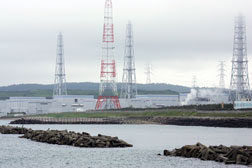 Photo: Kashiwazaki-Kariwa nuclear plant may be sitting on active seismic fault.
|
The aftershocks of the July 16 magnitude 6.6 earthquake that struck Japan’s Niigata Prefecture seem set to continue to rumble through the country’s nuclear power industry for some time. Its main facilities apparently withstood the shock, but a nuclear powerplant near the epicenter suffered significant damage and leaked trace amounts of radiation. A slow and sloppy response to the crisis and subsequent revelations that the plant may be over an active fault and underdesigned have raised questions about the safety of the nation’s nuclear power infrastructure.
“The people responsible for the nuclear powerplant say the earthquake and the strong ground motions were unexpected, but they could have been predicted,” says Katsuhiko Ishibashi, a seismologist at Kobe University who is skeptical about the safety of Japan’s nuclear plants.
The Niigata Prefecture Chuetsu-Oki Earthquake struck just offshore beneath the Sea of Japan about 455 kilometers northwest of Tokyo shortly after 10 a.m. on a national holiday. The quake killed 10, injured over 1,800 and left over 10,000 homeless. Damage was concentrated among older wooden post- and-beam structures long known to be vulnerable to earthquakes.
But the damage to the 8,212-MW Kashiwazaki-Kariwa Nuclear Power Station, the world’s largest nuclear plant, with five 1,100-MW boiling-water reactors and two 1,356-MW Advanced BWRs, has again shaken the public’s faith in Japan’s nuclear industry. By some measures, the plant performed well. The four operating reactors all shut down automatically. The other three were down for routine inspections. The reactor buildings appear to have withstood the tremors without damage.
But the handling of the crisis and revelations about possible design shortcomings have given plant owner Tokyo Electric Power Co. (TEPCO)--and nuclear power in general--a serious black eye. TEPCO’s plant personnel had trouble dousing a fire that engulfed a transformer. The utility was slow to report two minor leaks of radiation into the sea and later reported that its fire-fighting and radiation alert responses were hindered by damage to the plant’s communications systems. Government inspectors also found the company had miscalculated the amount of radiation released as well as a third, reportedly minor, leak into the atmosphere the company missed.
Problem reports also dribbled out, damaging TEPCO’s credibility. The company initially announced finding 50 problems resulting from the quake, including the fire, radiation leaks, toppled drums of nuclear waste and broken pipes. A couple days later it upped the tally to 63. Later still it reported that an overhead crane used to lift the lid of one reactor vessel was damaged, delaying inspection.
Getting the most attention, however, are revelations that the plant may be sitting above an active fault. TEPCO reported measuring expected peak ground accelerations of about 680 galileo, while the plant was designed for 270 galileo. Gravity’s acceleration is 980 galileo.
Engineers were generally not alarmed by the discrepancy. For one thing, Toshimi Kabeyasawa, a structural engineer at the University of Tokyo’s Earthquake Research Institute, notes that there is still an imperfect understanding of how ground accelerations really affect structures. And even at that, the buildings could probably withstand “three to four times” the imposed forces because of safety factors, he says.
But just how safe the buildings really are has caused concern. Ichiro Takekuro, a TEPCO vice president in charge of nuclear power, says the company will analyze all available data “to see what loads impacted the facilities and how they performed in relation to their design.” He adds that although the reactor buildings apparently performed well, it is clear that greater attention is needed to ancillary facilities to ensure continuity of communications links and fire-fighting capabilities. The plant is likely to be closed for a year or more.
TEPCO won’t be the only entity reviewing the seismic performance of the plant. Akira Fukushima, deputy director-general for safety at the Ministry of Economy, Trade and Industry’s Nuclear and Industrial Safety Agency, explains that new guidelines for the earthquake resistance of nuclear powerplants were released last September. The old guidelines required the examination of various scenarios, including the possibility of a magnitude 6.5 earthquake directly beneath a plant. The new guidelines require more thorough evaluation of existing faults and consideration of ground accelerations. This probably adds up to more stringent design criteria. All existing nuclear plants will have to be checked against the new criteria and retrofitted if needed, Fukushima says.
The guidelines could be further strengthened. The government has appointed a committee to review all aspects of nuclear plant safety in light of the recent earthquake. But that doesn’t seem likely to satisfy nuclear skeptics. A local citizens group has already announced its intention to go to court to keep the Kashiwazaki-Kariwa plant from ever restarting.

Post a comment to this article
Report Abusive Comment